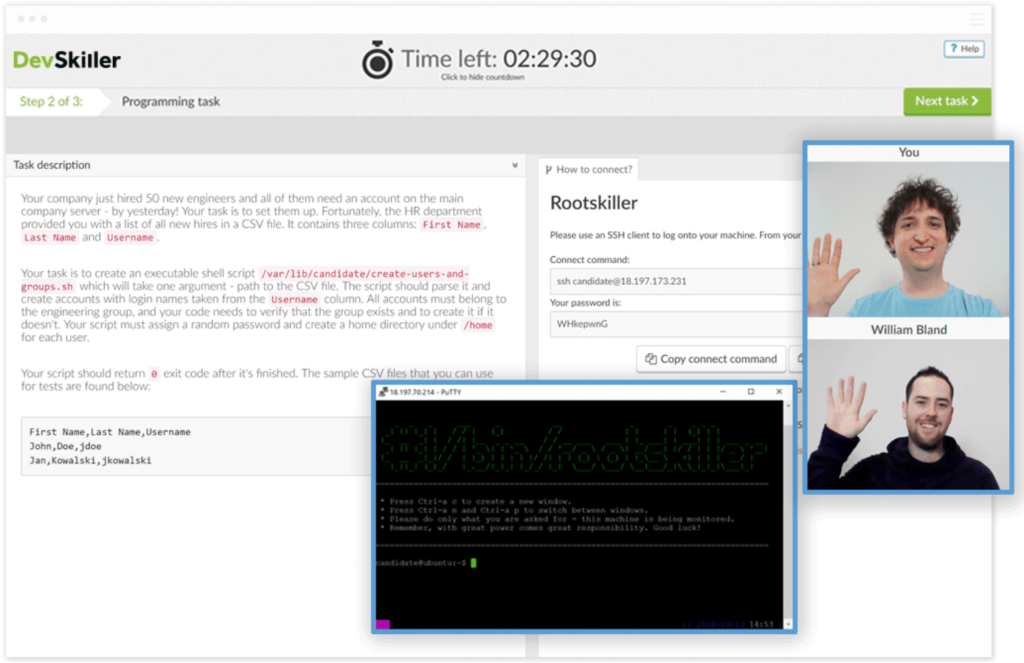
What is a competency assessment – all you need to know

에 따르면 LinkedIn’s Workplace Learning Report, more talent developers emphasize evaluating employees’ competency and eliminating skill and knowledge gaps. In fact, 74% use internal skill gap assessments to identify which skills are lacking.
In today’s article, we’re going to explain what a competency assessment is and what are the benefits and risks of running them. We’ll also tell you how to approach competency assessment measures and evaluation for your current and future employees.
목차
- What is a competency assessment
- Why are competency-based assessments important?
- How to approach competency assessments
- Summary
What is a competency assessment
Competency assessment, also known as competency evaluation, it’s the process of looking into the current skill levels of employees and determining the potential competencies they could acquire or enhance. If done for the entire team and against a specific standard, it reveals the skills gaps that need to be filled if a company wants to reach its strategic goals.

Source: Unsplash
Based on competency assessments, businesses can decide whether they need to recruit new team members with core competencies or are better off developing skills internally by providing employees with training.
Types of competency assessments
There are several types of competency assessments that organizations can utilize to evaluate employee skills and abilities:
Test-based assessment
This involves administering standardized tests or quizzes to measure specific knowledge or skills. For example, a coding test for software developers or a language proficiency exam for translators.
Observation-based assessment
This method involves observing employees as they perform tasks in their actual work environment. It can provide insights into practical skills and on-the-job behaviors.
Interview-based assessment
Structured interviews with specific competency-focused questions can help assess an employee’s knowledge, experience, and approach to work situations.
Project-based assessment
Assigning employees a project or task that requires them to demonstrate multiple competencies can provide a comprehensive view of their abilities in a real-world context.
Why are competency-based assessments important?
Competency-based assessments are an extremely powerful method used by HR to evaluate strengths and weaknesses on a per-employee and team level. Let us shed light on the benefits of running competence tests, and assess the risks associated with the lack thereof.
Benefits of running competency tests
Creating a skills inventory
Let’s assume you’re a software consultancy and your objective is to become the #1 provider of Python development services on Capterra within the next 2 years. Where do you start?
You can conduct a self assessment and skills audit to check how proficient each employee is in the technology. This way, you’ll have hard data on how far from reaching this business objective you are so you can design a complete plan to get there.
Understanding skill gaps and strengths at a granular level is crucial, with a focus on behavior-based assessments to target specific proficiency improvements. This approach allows organizations to create a comprehensive skills inventory that accurately reflects their workforce capabilities.
Identifying skills gaps
Competency tests will often reveal that your team lacks not just hard skills, but also soft skills like communication and a team attitude. For instance, one of your employees might have what it takes to become a team leader as far as hard skills are concerned. However, their communication skills might be below the required standard. Knowing this will keep you from filling a senior role with someone who lacks the stamina to run a team. From there, you can make a conscious decision whether you want this person to work on that skill or take another course of action.
Soft skills, such as innovation, critical thinking, strategic thinking, and design thinking, are growing in importance due to automation, digitization, and AI. Competency assessments help identify these crucial skill gaps, which is a global issue costing organizations significant amounts in lost productivity and competitive advantage.
Creating better training plans
A common mistake that companies lacking competency assessments make is sending the entire team to the same training. The problem being that not all team members need it, as they might already be knowledgeable about the subject.
With competency assessments, you can not only save your employees’ time but also direct them to a better-tailored training that fits their skillset. Another advantage of the competency model? If you conduct competence tests continuously, you’ll be able to evaluate whether the training has, in fact, enhanced your employees’ skills.
Source: Unsplash
When individuals take ownership of closing their skill gaps, the organization’s overall skill gaps close, leading to higher engagement and satisfaction among employees. This approach to training and development fosters a culture of continuous learning and improvement.
Designing career paths
If you know what skills your employees possess, you can design career paths for them. This will boost motivation, with employees feeling a sense of purpose in the organization. With a clear understanding of your current team’s skills, you can also start planning career paths for new employees. This will help you establish an attractive employer brand.
Saving on recruitment
Last, but not least, if you can fill a skills gap with your current employees, you’ll be saving on recruitment. Bear in mind that in IT, the costs of hiring a single employee can reach an astounding $32,000!
The risks of ignoring competency tests
Giving up on the competency assessment system can have serious business consequences. We’ll now discuss some of them.
High turnover
The main aim of conducting a competency assessment is to make sure that you hire the most suitable candidates. Those who possess the technical skills to perform the job to a certain standard. If you fail to incorporate a competency assessment data-based assessment in your recruitment, you might end up with underqualified or overqualified candidates. Both of which will most probably decide to leave your organization shortly after being hired. According to the Employee Benefits News, it costs employers 33% of a worker’s salary to hire a replacement for them, so there is a lot at stake here.
Lower employee morale
Let’s return to the above-mentioned scenario. High turnover usually has a bad impact on employee morale. Not only do other team members get upset about losing their colleagues but they’re also overworked as often, they end up taking over some of their responsibilities. Additionally, as more people quit their jobs, it might lead to a snowball effect, i.e., other employees following in their footsteps.
Poor reputation
The business world is not as large as it might seem. And the topic of high employee turnover is frequently discussed. It can create a poor reputation and negatively impact candidates’ willingness to apply for work at your organization.
Lack of talent development opportunities
Your employees are the driving force behind organizational growth. If you don’t regularly conduct skills assessments to check what abilities you have and which are lacking, you prevent employees from developing new skills. This can not only lead to less employee performance and demotivation, as talented employees want to learn continuously, but you’ll also inhibit business growth.
Longer and more costly recruitment process
As mentioned in the previous section, recruitment is a time-consuming and expensive process, as you have to verify both soft and hard competency-based interviews and skills. You have to involve a lot of people like HR, developers, team leaders, etc. If you spend a lot of time conducting in-person interviews to check the culture fit without verifying candidates’ tech skills first, it’s time wasted. Start with competency assessments and only invite suitable candidates to in-person interviews.
Components of a competency framework
A well-designed competency framework typically includes:
- Core competencies: Skills and behaviors essential for all employees across the organization.
- Functional competencies: Specific skills required for particular roles or departments.
- Leadership competencies: Skills and behaviors expected from those in management positions.
- Technical competencies: Specific knowledge and skills related to job functions.
- Behavioral indicators: Observable actions that demonstrate proficiency in each competency.
These components provide a structured approach to assessing and developing employee skills aligned with organizational goals.
How to approach competency assessments
Now we can move on to discussing how to conduct competency evaluation. Let’s start with your current employees.
Assessing your current employees
Skills inventory
Begin your skills gap analysis by running a skills inventory with HR – remember to evaluate both technical and soft skills. This will show you what skill gaps your team has. It’s a great starting point to see which skills can be developed inside the organization and which must be acquired externally.
Skills gap assessment/analysis
Use a solution like TalentBoost to get a bird’s eye view of your company skills – either on a team or per-employee level. Based on your findings, you can decide how to proceed. Whether to conduct training, design the right career paths for your current employees, require additional training, or decide on hiring for the skills you currently lack.
Source: TalentBoost
Implementing competency assessments in the workplace
Creating transparency in the process
It’s crucial to communicate clearly with employees about the purpose and process of competency assessments. This transparency helps reduce anxiety and increases engagement in the assessment process.
Developing personalized training plans
Use the results of competency assessments to create tailored development plans for each employee. This personalized approach ensures that training resources are used efficiently and employees feel supported in their growth.
Assessing candidates
Work sample coding tests
Work sample coding tests let you evaluate candidates’ IT skills in the screening stage. With DevSkiller’s TalentScore solution, you can filter out applicants who have poor skills and focus the remainder of your recruitment on the very best candidates.
For the candidates you do decide to hire, you can use the skills assessment data and the information gathered at the recruitment stage to keep track of what they bring to the organization. One way of doing so is to merge your technical screening data with your 기술 관리 solution to create data-rich profiles.

Source: DevSkiller
Soft skills evaluation
For candidates with high work sample test results, schedule a soft skills evaluation with HR and the hiring manager. This way, you’ll be able to check if the applicant seems like a good fit for the team.
Tech interviews
Once you’ve shortlisted your candidates, schedule a tech interview. You can conduct a pair programming session, where the hiring manager and/or tech lead works with the applicant on a live task. You can use TalentScore to organize pair programming remotely.

Source: DevSkiller
Discuss career objectives
Before you decide to extend a job offer, schedule a quick call or meeting to discuss your candidate’s career objectives. You need to ensure that their interests and long-term goals align with the growth opportunities at your company and see how you can tap into them to keep the candidate engaged. While you might lose highly skilled candidates at the last stage, it might be for the greater good as you’ll prevent employee attrition.
Skills-specific employee onboarding
Last, but not least, focus your employee onboarding and training programs on skills that are either most important for the job from ‘day one’ or those that you want them to eventually develop.
Measuring the effectiveness of competency assessments
To ensure that your competency assessment program is delivering value:
- Track improvements in individual and team performance over time.
- Monitor changes in key performance indicators (KPIs) related to the assessed competencies.
- Gather feedback from employees and managers on the assessment process and its outcomes.
- Regularly review and update your competency framework to keep it aligned with evolving business needs.
Competency assessments for career development
Competency assessments can be powerful tools for career development:
- They help employees identify their strengths and areas for improvement.
- Assessments can guide employees in selecting appropriate training and development opportunities.
- They provide a clear roadmap for career progression within the organization.
- Regular assessments can track an employee’s growth and readiness for new roles or responsibilities.
Using competency assessments for rapid onboarding
Competency assessments can significantly streamline the onboarding process:
- They help identify new hires’ existing skills and knowledge gaps.
- This information allows for tailored onboarding plans that focus on areas needing development.
- Assessments can be used to match new employees with appropriate mentors based on complementary skills.
- Regular check-ins using competency assessments can track a new hire’s progress and integration into the team.
Summary
Competency assessments help organizations become aware of the skills and skills gaps of their employees. This information is incredibly valuable from a strategic point of view for C-level, management, and HR. Firstly, it allows them to plan how they can upskill employees to avoid recruitment costs. Secondly, if they need to hire externally, competence assessments will help them craft candidate requirements for optimal results.
Competency assessments are also beneficial when it comes to rapid onboarding and additional training. Assessing a new hire as soon as they start or using the data obtained at the recruitment stage, will help you quickly establish the areas that need development. Furthermore, you can also use competency assessments to evaluate the effectiveness of training and tailor it for each employee.
Last, but not least, aligning the goals and specific competencies of the company with those of the individual will benefit both groups and boost employee satisfaction and retention rates. If you’d like to see how competence assessments can support your talent management strategy, give TalentBoost a try!




